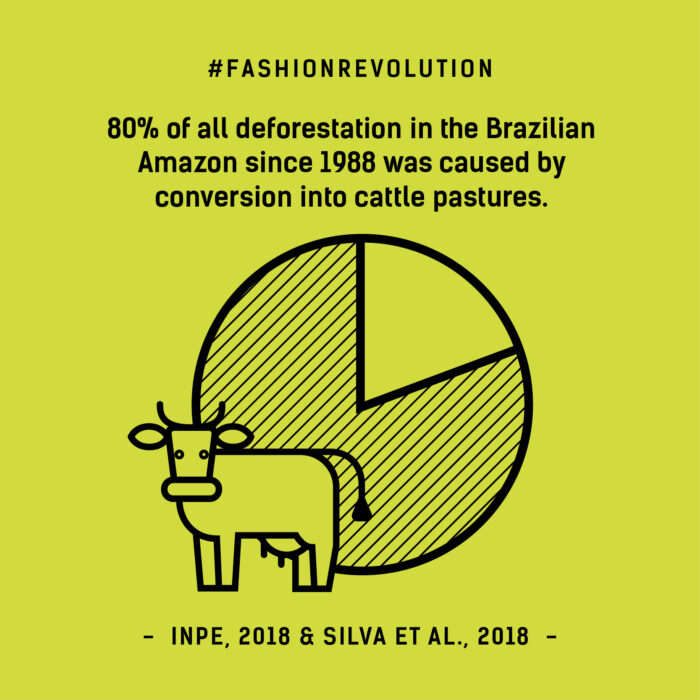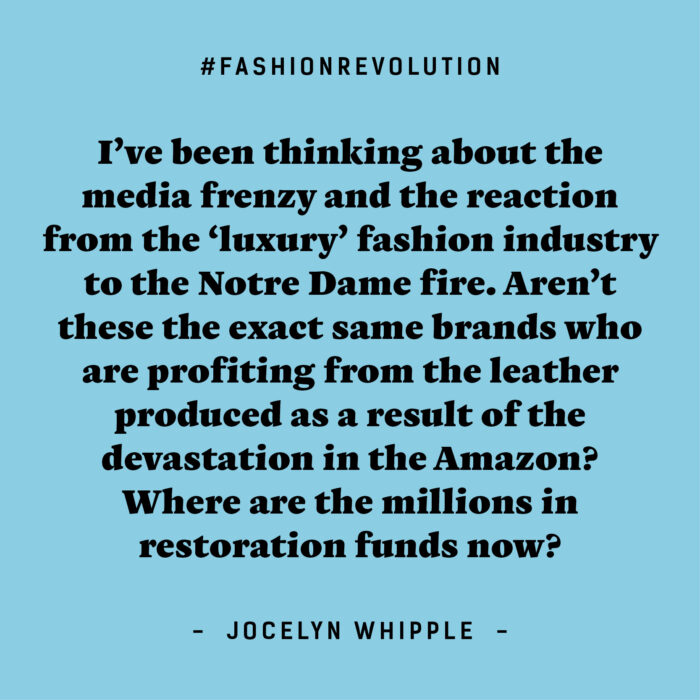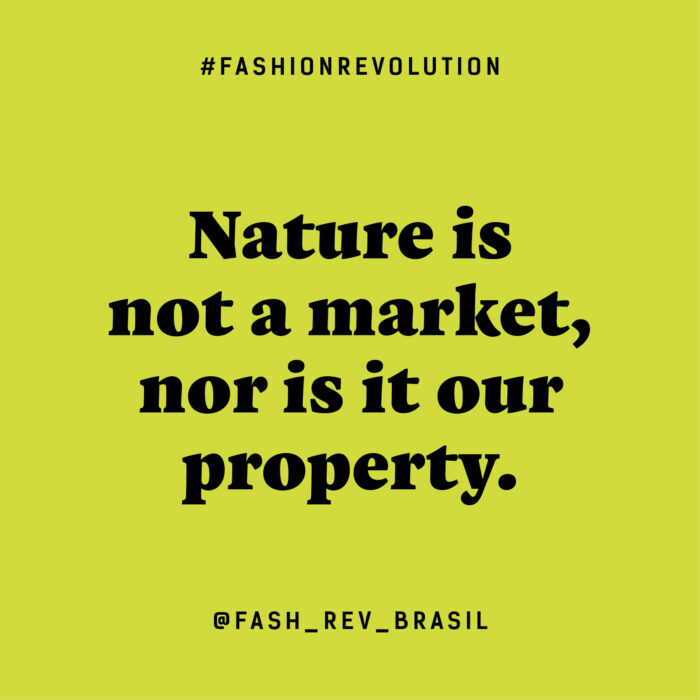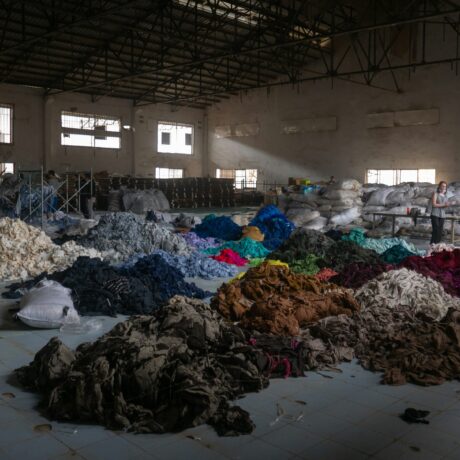While the rainforest burns, we need to know where our leather comes from
Fashion Revolution shares the world’s condemnation of the burning of the Amazon Rainsforest, not least because of its links with the fashion, footwear and accessories industries. Scientists at Brazil’s National Institute of Space Research calculate that there have been 35% more fires so far this year than average in the last eight years.
Brazil is the second biggest exporter of beef supplying 20% of the world’s beef (second only to America). It follows that Brazil’s cattle rangers are supplying the same proportion of the world’s leather. The fashion industry must take responsibility for the leather handbags, shoes and accessories contributing to the deforestation of the rainforests.
Many brands were implicated in sourcing their leather from cattle reared in rainforest affected by deforestation by a Greenpeace report Slaughtering the Amazon in 2009. While several brands rushed to distance themselves from the report, ten years on, there is little progress in terms of transparency on leather sourcing for shoes, handbags and leather goods. As the devastation caused by clearing the rainforest for cattle rearing is increasingly condemned globally, it is not good enough for brands not to give full disclosure on the sourcing of their raw materials, particularly leather.


A brief survey of a few luxury brands this week revealed no information whatsoever about the country of origin of leather used. “Italian leather” simply means the leather was tanned and processed in Italy. The origins of the hides is obscure and the supply chains opaque, hiding a whole range of issues including the welfare of the animals. As citizens we must demand the right to know where the leather we are buying has been sourced – and that brands are not contributing to the deforestation of the Amazon Rainforest.
Only 5 per cent of brands investigated as part of the Fashion Transparency Index 2019 publish some of their raw material suppliers – most commonly cotton and wool. As Abhishek Jani, Chief Executive Officer Fairtrade India Project wrote in this year’s report, we need more transparency at fibre and farm level: “With fashion being the one of the most polluting industries in the world, it is encouraging to see that the industry is now systematically engaging with the transparency.”
“Going forward, it is crucial that we not only stay committed but also deepen engagement to minimise exploitation and maximise positive impact across the entire life-cycle of fashion products,” he wrote. “Practices right from the garment factories down to the selection of the raw material. While there have been some incremental improvements in the degree of disclosure and transparency with regards to raw material sourcing, we are still just scratching the surface.”
While this is an issue for governments to regulate and corporations to come clean on, we can make sure our favourite brands know we want action. It is clearly going to take a lot more than the G7’s $20m pledge to start reforestation. Ahead of the UN Climate meeting in New York next month, we can make our voices heard that we do not want to support corporations who are not disclosing on their leather supply chains. A good place to start finding out who is and isn’t disclosing information on sourcing practices from regions at risk of deforestation is the Campaign for Carbon Disclosure’s Global Forests Report.
Over the last few days Fashion Revolution’s Global Network Program and Content Manager Jocelyn Whipple has been in contact with Fashion Revolution teams in countries affected by the irreversible destruction to our earth’s rainforests, in particular @fash_rev_brasil and @fash_rev_madagascar. Madagascar is suffering extreme deforestation in a very similar way to Brazil, Jocelyn points out, as is Indonesia – the list goes on.
“I’ve also been thinking about the media frenzy and the reaction from the ‘luxury’ fashion industry to the Notre Dame fire,” writes Jocelyn. “Aren’t these the exact same brands who are profiting from the leather produced as a result of the devastation in the Amazon? Where are the millions in restoration funds now? Nothing about this is luxurious, everything about this is devastating.”

From @fash_rev_madagascar:
De nos jours, nous vivons dans une société écocide, nous vivons pour la plupart dans notre bulle. Avec les effets néfastes de la mondialisation, tout comme l’impact de la mode ou le désastre de la forêt amazonienne, nous les consommateurs nous devons nous informer de la provenance des ressources naturelles qui nous entourent, et sur ceux qui restent invisibles plus loin dans la chaîne d’approvisionnement des produits. N’attendons pas une nouvelle catastrophe pour faire bouger les lignes ! A nous de jouer ! ???#fairtrade #sustainability
Nowadays, we live in an ecocide society, we live for the most part in our bubble. With the harmful effects of globalization, as well as the impact of fashion or the disaster of the Amazon rainforest, we consumers need to be aware of the origin of the natural resources that surround us, and on those that remain invisible. Further into the product supply chain. Let’s not wait for another disaster to move the lines! It’s up to us! ???#fairtrade#sustainability
A plea from @Fash_Rev_Brasil:
A Amazônia é a maior floresta tropical da Terra. Está situada, majoritariamente, no Brasil: temos 60% do seu território, e o resto se divide entre outros 8 países da América do Sul.
⠀
Nos últimos dias, junto com o centro-oeste, nossa floresta vem sofrendo com incêndios que não eram tão intensos desde 2013, conforme o INPE (Instituto Nacional de Pesquisas Espaciais). Não há precisão de quando começaram, mas especialistas afirmam que são causados pelo tempo seco juntamente com a ação de moradores, fazendeiros e grileiros para expandir terrenos e áreas de cultivo.
⠀
A realidade das imagens e depoimentos é chocante e nos questionamos como chegamos a este ponto. Diversas seriam as respostas, pois complexos são os desafios que enfrentamos quando falamos em preservação ambiental e olhamos para nossos modelos de negócios, muito em decadência pela sua insustentabilidade.
⠀
A Natureza não é um mercado, tampouco nossa propriedade. Somos seus integrantes e temos responsabilidades, a níveis individuais e coletivos, em garantir sua proteção e regeneração, convivendo em harmonia. Porém, cada vez mais destruímos e exploramos em detrimento de sistemas bem artimanhados, domínios de poder e outros motivos de ordem econômica, social e cultural.
⠀
Diante desse colapso climático, se engajar não é – ou nunca foi – uma opção: as pautas ambientais são uma urgência. Garantir isso é garantir a vida na Terra. Mudar a consciência e ações particulares são importantes, mas olhar sistemicamente é necessário para projeção de políticas e ações no macro.
⠀
Algumas instituições atuam nessa luta: @renaturefoundation, @socioambiental, Instituto Centro de Vida (ICP), Imazon, @ipam_amazonia, @kanindebrazil, e outras. Precisamos fortalecê-las, precisamos nos atentar, precisamos nos organiazar. Se você conhece outras, deixe nos comentários!
⠀
E o que a moda tem a ver com isso? Tudo. Porque sem Terra não haverá nada, tampouco a moda que tanto insistimos em sustentabilizar.The Amazon is the largest rainforest on Earth. It is mainly located in Brazil: We have 60% of its territory, and the rest is divided among 8 other countries in South America.
⠀
In the last days, along with the Midwest, our forest has been suffering from fires that were not so intense since 2013, according to INPE (National Institute of Space Research). There is no accuracy when they started, but experts claim that they are caused by dry weather along with the action of villagers, farmers and grileiros to expand land and cultivation areas.
⠀
The reality of images and testimonials is shocking and we question how we come to this point. Several would be the answers, because complexes are the challenges we face when we talk about environmental preservation and we look at our business models, much in decline for their unsustainability.
⠀
Nature is not a market, nor is it our property. We are its members and have responsibilities, at individual and collective levels, to guarantee their protection and regeneration, living in harmony. However, we increasingly destroy and exploit to the detriment of well-artisticed systems, power domains and other economic, social and cultural motives.
⠀
Given this climate collapse, engaging is not-or has never been-an option: environmental agendas are an urgency. To ensure this is to ensure life on Earth. Changing awareness and particular actions are important, but looking systemically is necessary for projection of policies and actions in the macro.
⠀
Some institutions work in this fight: @renaturefoundation, @socioambiental, Instituto Centro de Vida (ICP), Imazon, @ipam_amazonia, @kanindebrazil, and others. We need to strengthen them, we need to pay attention, we need the Organiazar. If you know others, leave in the comments!
⠀
And what does fashion have to do with it? All. Because without Earth there will be nothing, nor the fashion we insist on sustaining.

What can we do?
As a community, we cannot sit back and be part of a system that burns trees to provide meat and leather for industries that are already over producing. The fact is that increasing numbers of people are becoming vegan and opting for alternatives to leather. The number of Americans identifying as vegan increased by 600% between 2014 and 2017 according to GlobalData. In the UK there are over 3.5 million vegans. Yet leather shoe production is booming. In 2017, global footwear production reached 23.5 billion pairs, an increase of 2% on the previous year. Not all of these shoes are leather, but it would be good to know that the company that made your shoes – and your bags – is not profiting from the deforestation of the rainforests.
Ask the brands you trust to tell you where they are sourcing the leather for their shoes and bags. We need transparency on this issue so we know that our brands are doing the right thing. Tag them on social media, and let us know the answers!
Please also join us at Fashion Revolution in signing the Greenpeace petition and standing with the over 180 different Indigenous Peoples and thousands of local communities who live in the Amazon so stop the deforestation and save the rainforests.
Watch this video from Reuters: The Tribes Fighting to Save their dying Rainforest
Read the reports and articles by Global Canopy
*Banner image is by Carl de Souza / Getty Images*








